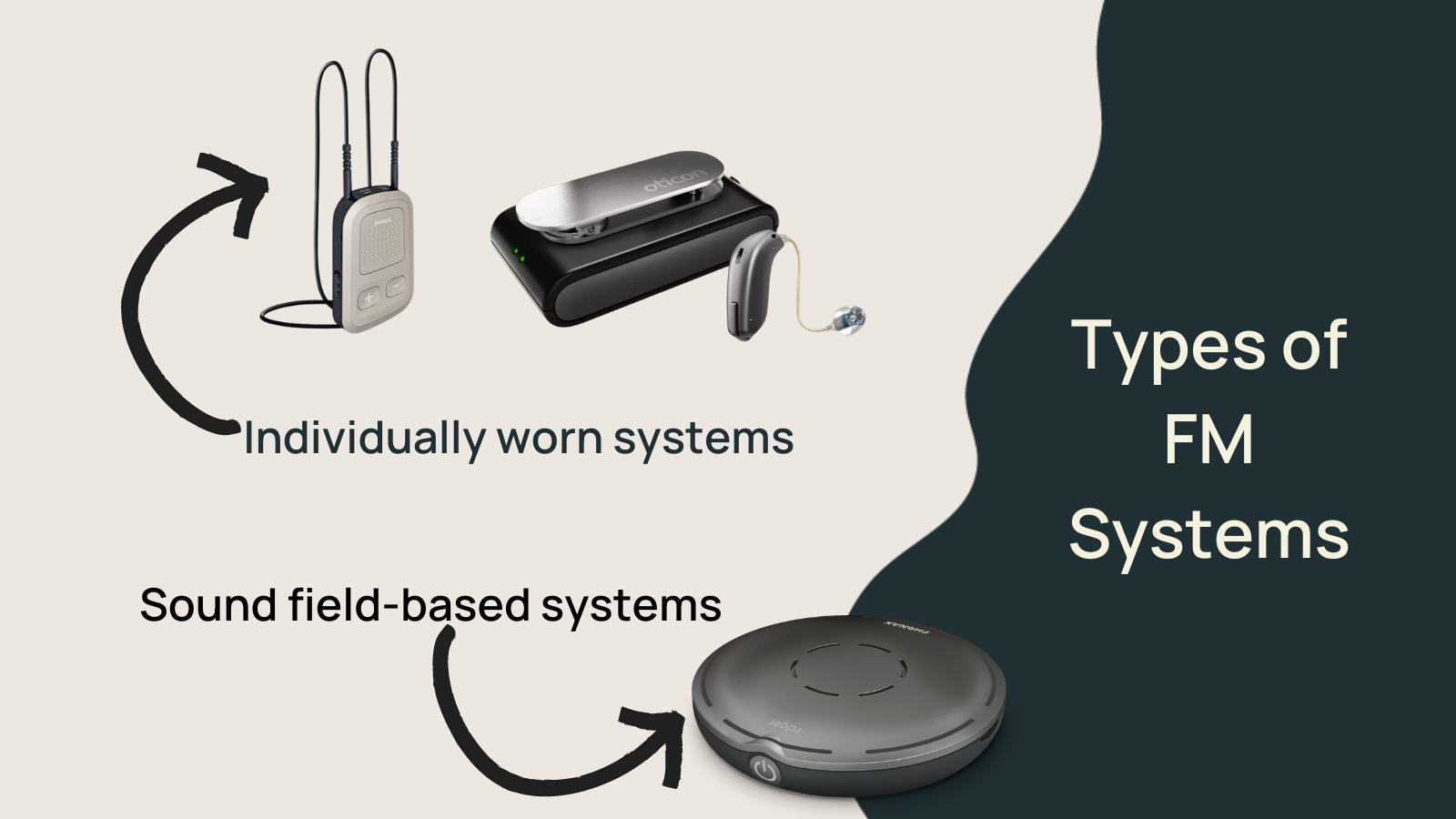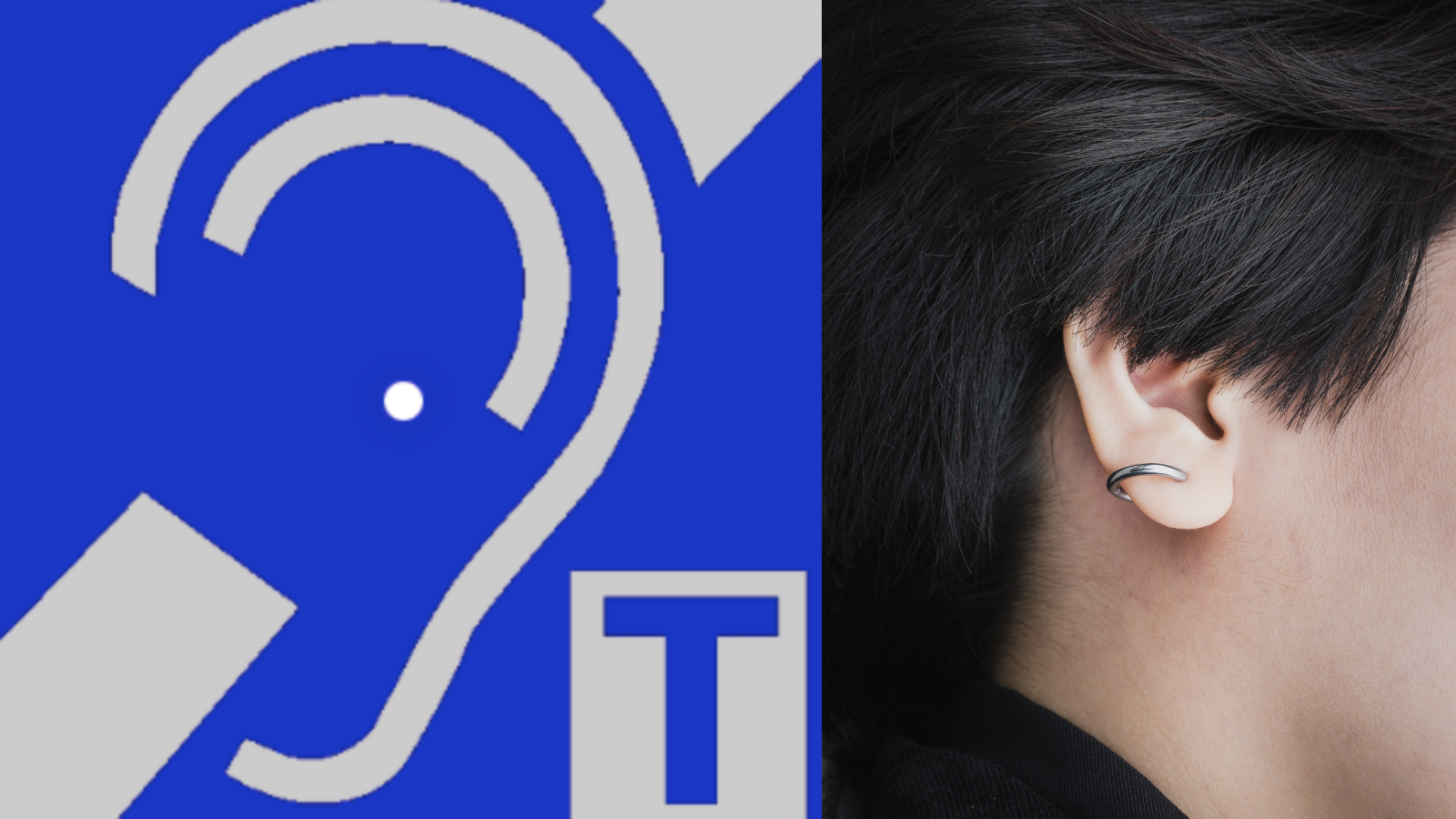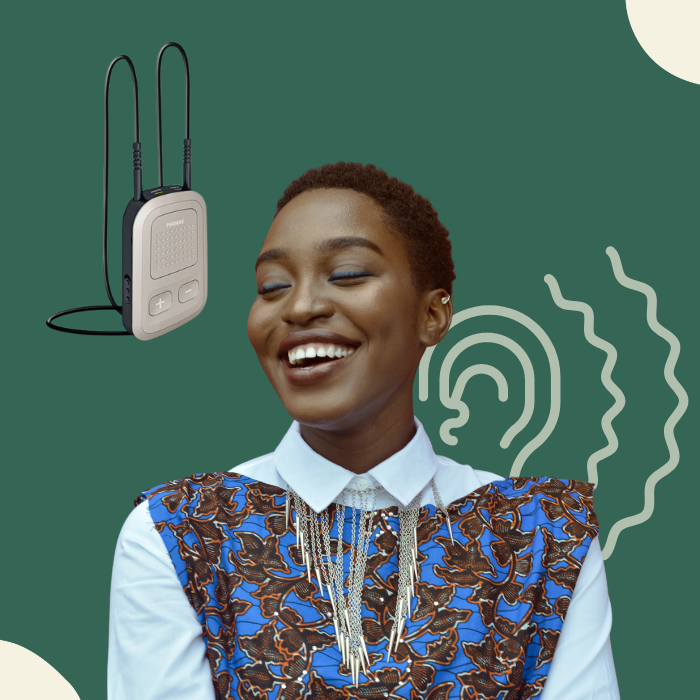Key Takeaways:
- An FM system is a helpful option for those who struggle to hear in background noise.
- FM systems come in two categories: individually worn systems and soundfield-based systems.
- Auracast is a new technology that will be implemented in the coming years to provide increased audibility in more public settings.

If you have hearing loss, using an FM system can significantly improve hearing ability in various settings. An FM system assists with speech understanding in adverse listening environments.
FM systems can be used at school, work, and other public settings where background noise is loud or distracting. Below, we’ll take a closer look at how FM systems work, who they’re for, and what options are available.
What is an FM system?

First things first, what exactly is an FM system? An FM system stands for frequency modulation system, and it is made of two parts: a remote microphone and a receiver (another word for speaker).
A presenter—for example, a teacher in a classroom—wears a remote microphone. Next, the receiver picks up and receives an amplified version of the speech signal. This wireless assistive technology enhances the speech signal similarly to cutting through background noise or shortening the speaker's distance to create a clearer and more easily understood speech signal.
Many people with hearing loss have difficulty hearing in background noise or challenging listening environments. Distance, noise, and reverberation can make it harder to hear a person’s speech. The idea of an FM system is to increase the volume of the speech signal in relation to the competing background noise.
There is another version called a DM system that works the same as an FM system but utilizes a digital signal rather than a radio signal. The result is a clearer signal without interference that radio signals (or static sounds) can produce. Note: Both FM and DM systems are often referred to as FM systems.
Types of FM Systems

There are several different FM systems available depending on your specific needs. The two main categories are individually worn systems (connected to a user’s hearing devices), and sound field-based systems.
Systems connected to the user’s hearing technology use an external microphone connected to a receiver that the user wears. These receivers are connected to the user’s hearing technology and provide a clear signal directly into the ear.
Soundfield-based systems use transmitters around the room that broadcast audio signals to speakers in the room to amplify the sound for everyone. These are useful in larger environments such as classrooms, auditoriums, and gyms. Moreover, this can even be beneficial for children without hearing loss as this creates a more accessible listening atmosphere, and there will be less interference from background noise.
Types of microphones that can work in an FM system:
- Clip-on microphones
- Handheld microphones
- Table-top microphones
Types of receivers (speakers):
- Loudspeakers: Sends the signal from the microphone to loudspeakers in a room.
- Neckloop receivers: Sends the signal to your hearing aids through electromagnetic energy and a telecoil.
- Ear-level receivers: Sends the signal directly to your hearing aid or cochlear implant.
- Body-worn receivers: Sends the signal to a receiver that can be attached to headphones for those who do not have hearing aids. This option is bulkier but offers audibility in certain situations.
Roger Select

One useful FM system is Phonak Roger Select, a system that connects via a Bluetooth signal rather than a radio frequency. It connects a wireless microphone to receivers connected to your hearing aid or cochlear implant. The result is a clearer speech signal with less background noise, making for a more effortless listening experience. Another added benefit? The Roger Select is universal and works with any hearing aid manufacturer.
Roger Select is a fantastic option for an FM system, but it is a pricier option and typically costs several thousand dollars for the receivers and microphone setup. Which means, it’s important to speak with a local audiologist for specific pricing. Cochlear implant recipients can select this option as one of their accessories at no additional cost.
What is a telecoil?

Housed within the hearing aid, the telecoil is a tiny copper wire coiled around a metal rod. Telecoils allow the hearing aid to work like a personal wireless speaker. In settings with a looped system, you can engage the telecoil feature on the hearing aid and enjoy a clearer, succinct audio stream. For example, you’ll hear a presentation, musical performance, or a speech directly in the ear without the background noise you would otherwise get while listening with hearing aids.
How will you know when telecoil is an available option? Look for a telecoil sign in auditoriums, churches, performance venues, or other settings.
Who are they for?
FM systems are ideal for people with all levels of hearing loss who struggle with background noise. They can be used in conjunction with hearing aids or cochlear implants as well. Still, these systems don't replace assistive devices—they simply amplify speech so those with hearing loss can better understand when background noise, distance, or reverberation is present.
Even those with normal hearing who struggle with background noise can benefit from using an FM system.
How do I choose one?
Choosing the right FM system depends largely on your individual needs, hearing technology, and budget. If you’re considering FM options for your child at school, get in touch with the school audiologist, as they will have their own requirements regarding which systems the school or district uses. Your audiologist can discuss the options available and help you decide which is best for you or a loved one.
Here are some options:
Universal Systems
Manufacturer Specific Options Include:
Note: Speak with your audiologist about technology options above and compatibility with your specific hearing devices.
FAQs

Where can I use one?
There are a variety of options for when and where you can use an FM system. These include meetings, at the dinner table, in the car, at school, in lectures, in auditoriums, when walking, or even at home. For example, some of my patients struggle to hear their family when out at noisy restaurants. An FM system works well there because the family member can clip the microphone on their shirt, making the conversation much easier to follow.
Looking for tips about when to use this technology at home for your child? Check out this handy guide.
Are FM systems an alternative to hearing aids?
No—while they do amplify sound similarly to hearing aids, FM systems serve different purposes and should not be seen as replacements. Hearing aids provide sound amplification directly into the user's ear, whereas an FM system uses external microphones that broadcast audio signals directly into receivers worn by those with hearing loss.
What about built-in systems like Auracast?
Auracast is a new, emerging infrastructure that will utilize the new Bluetooth LE protocol to allow people to receive audio directly to their hearing aids or headphones. This technology is not yet widely available but is on the horizon in the coming years. Once Auracast is readily available, it will be the easiest way to pick up audio signals without needing an intermediary device. Currently, FM systems and telecoil options still provide the best way to receive clearer audio.
How much do FM systems cost?
Prices vary greatly depending on the type of product and technology. For example, an inexpensive option like a Pocket Talker can help a senior participate in a conversation with a family member and generally cost between $100 to $200. Generally speaking, prices range from around several hundred to several thousand dollars for an FM system. Consult with your hearing care provider about your best options for your needs and your budget.
Conclusion
FM systems are helpful for anyone who has difficulty understanding speech due to background noise or distance from the speaker—especially those with hearing loss. There are numerous types available, ranging from individually-worn units to room-based units depending on your individual needs, setting, and preferred usage scenario. An audiologist should be able to provide guidance when deciding which option is best for you—so reach out if necessary. With this knowledge under your belt, all that’s left is finding the right product.






